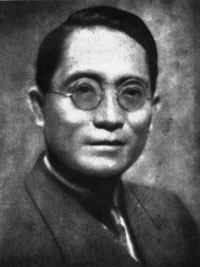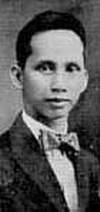
NICANOR ABELARDO
Abelardo was born in San Miguel de Mayumo, Bulacan. His mother belonged to a family of artists in Guagua, the Hensons. He was introduced to music when he was five years old, when his father taught him the solfeggio and the banduria. At the age of 8, he was able to compose his first work, a waltz entitled "Ang Unang Buko," which was dedicated to his grandmother. At the age of 13, he was already playing at saloons and cabarets in Manila. At age 15, he was already teaching in barrio schools in San Ildefonso and San Miguel Bulacan. All of these happened even before young Abelardo finally took up courses under Guy F. Harrison and Robert Schofield at the UP Conservatory of Music in 1916. By 1924, following a teacher’s certificate in science and composition received in 1921, he was appointed head of the composition department at the Conservatory. Years later, he ran a boarding school for young musicians, and among his students were National Artist Antonino Buenaventura, Alfredo Lozano and Lucino Sacramento. In the field of composition he is known for his redefinition of the kundiman, bringing the genre to art-song status. Among his works were "Nasaan Ka Irog," "Magbalik Ka Hirang," and "Himutok." He died in 1934 at the age of 41, leaving a prolific collection of more than 140 works.
As a composition major at the University of the Philippines, he also composed the melody for the university's official anthem, U.P. Naming Mahal.
The building housing the College of Music in UP Diliman (Abelardo Hall) is named in his honor.

FRANCISCO SANTIAGO
Francisco Santiago, The Father of Kundiman Art Song was born in Santa Maria, Bulacan, Philippines, on January 29, 1889 to musically-minded peasant parents, Felipe Santiago and Maria Santiago.
In 1908, his first composition, Purita, was dedicated to the first Carnival Queen, Miss Pura Villanueva, who later married the distinguished scholar Teodoro Kalaw.
Santiago's masterpiece was the "Concerto in B flat minor" for pianoforte and orchestra. His most famous piece "Kundiman, (Anak-Dalita)", was sung upon the request of King Alfonso XIII before the Royal Court of Spain.
His other compositions are the kundiman "Sakali Man", "Hibik ng Filipinas", "Pakiusap", "Ang Pag-ibig", "Suyuan", "Alaala Kita", "Ikaw at Ako", "Ano Kaya ang Kapalaran?", "Hatol Hari Kaya?", "Sakali't Mamatay", "Dalit ng Pag-ibig", "Aking Bituin", "Madaling Araw" and "Pagsikat ng Araw". He was named UP Emeritus Professor of Piano, on May 25, 1946. When the University of the Philippines Conservatory of Music was celebrating its 30th anniversary, the nationalistic musician died of heart attack on September 28, 1947. He was buried at the North Cemetery, Manila.